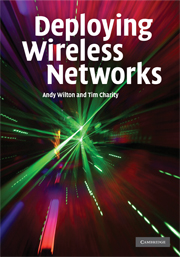Book contents
- Frontmatter
- Contents
- Foreword by Sir David Brown, FREng
- Preface
- Acknowledgements
- Authors' disclaimer
- 1 Introduction
- 2 Wireless network systems
- 3 Principles of access network planning
- 4 Introduction to RAN planning and design
- 5 GSM RAN planning and design
- 6 UMTS RAN planning and design
- 7 Cellular OFDM RAN planning and design
- 8 Mesh network planning and design
- 9 Core network and transmission
- 10 Network operation and optimisation
- Acronyms
- Index
- References
2 - Wireless network systems
Published online by Cambridge University Press: 13 August 2009
- Frontmatter
- Contents
- Foreword by Sir David Brown, FREng
- Preface
- Acknowledgements
- Authors' disclaimer
- 1 Introduction
- 2 Wireless network systems
- 3 Principles of access network planning
- 4 Introduction to RAN planning and design
- 5 GSM RAN planning and design
- 6 UMTS RAN planning and design
- 7 Cellular OFDM RAN planning and design
- 8 Mesh network planning and design
- 9 Core network and transmission
- 10 Network operation and optimisation
- Acronyms
- Index
- References
Summary
The discussion in Chapter 1 indicated that dividing the planned coverage area into a number of radio cells results in a more spectrally efficient solution with smaller and lighter end-user devices. In such a network, as the individual moves further away from the cell to which he or she is currently connected, the signal strength at the mobile eventually falls to a level where correct operation cannot be guaranteed and the call may ‘drop’. However, because the cellular system is designed to ensure good coverage over the plan region there will be one or more other cells at this location that can be received at adequate signal strength, provided some mechanism is found to ‘hand over’ the call to one of these cells. Most of the complexity in practical cellular systems arises from the need to achieve this handover in a way that makes this process as imperceptible to the user as possible.
This chapter aims to establish a common understanding of the way most cellular networks operate, using the ubiquitous GSM system as a baseline, and highlight the key differences that can be expected in networks providing fixed or ‘nomadic’ wireless access. It will also explore the factors that significantly contribute to cellular network operating expense and thus determine activities that impact the operators' profit and loss account. Finally, the profit and loss account will be used as an agenda to identify wireless network technologies that are likely to change in the future.
- Type
- Chapter
- Information
- Deploying Wireless Networks , pp. 10 - 44Publisher: Cambridge University PressPrint publication year: 2008



